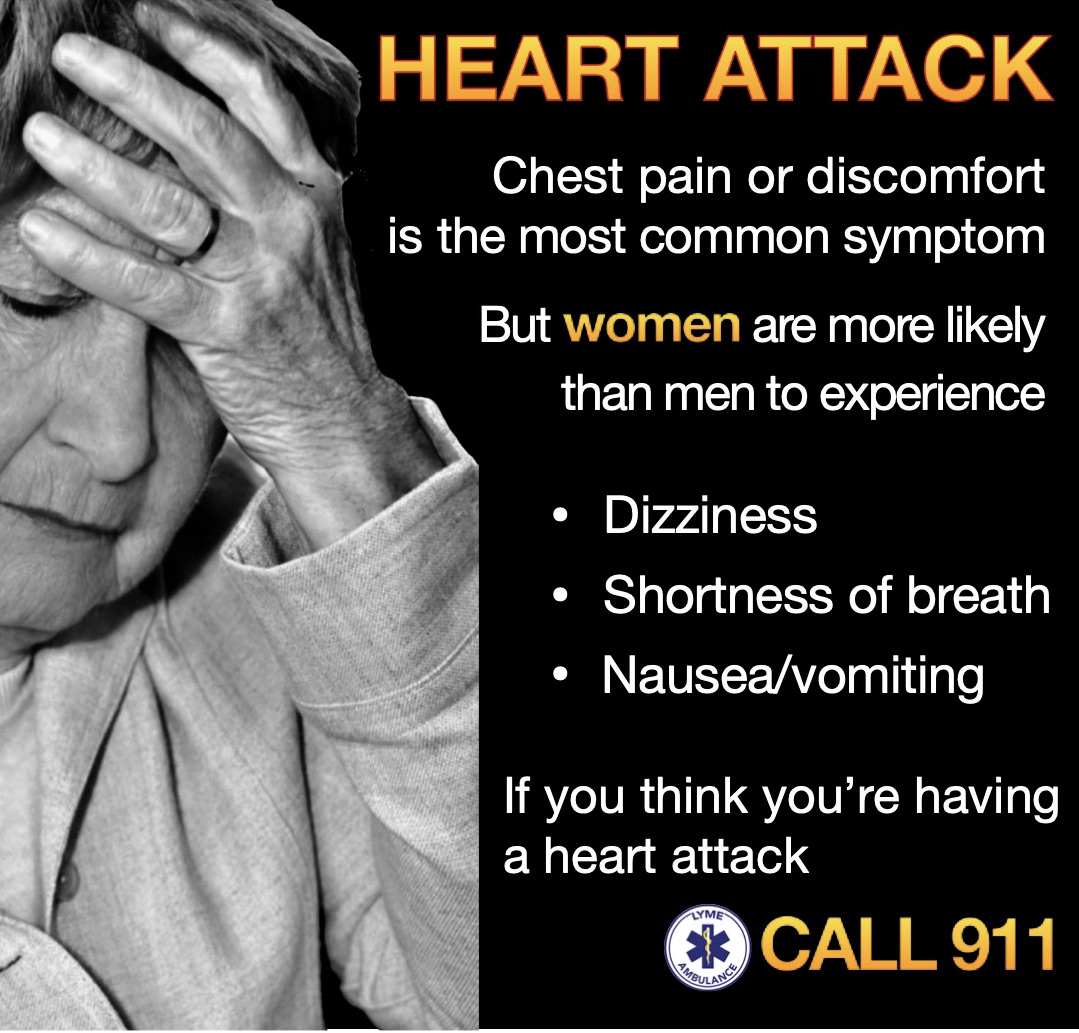
‘EMERGENCY 101’

Emergencies rarely give warning, but there are things you can do to help prepare your household — and help us deliver the best possible response in a medical emergency.
- Fill out a ‘FILE OF LIFE’ form
- Ensure your house number is visible
- Know the signs: heart attack & stroke
- Audit your home for safety
- Know how to stop bleeding
- Learn ‘hands-only’ CPR (VIDEO)
- Disasters happen: Have a plan
- Special needs? Let us know
- Flashing green lights? Move over!
TIP #1
Fill out a ‘File of Life’
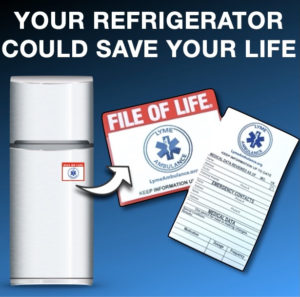
What is it? The ‘File of Life’ kit organizes important health data for you and your family so it’s quickly available to care providers if there’s a medical emergency. The file includes information on drug allergies, significant medical conditions, prescriptions and dosages, as well as contact information for your doctor.
- One form for each family member
- Place all forms in the red holder
- Display in a prominent location
- Keep the information current
GET A FREE
‘FILE OF LIFE’ KIT
▼
Email your request to:
deputychief
@lymeambulance.org
Or write to:
Ariana Eaton
Lyme Ambulance Association, Inc.
P.O. Box 911
Hadlyme, CT 06439
Include your full name, mailing address, and number and size of forms needed. Two sizes are available: Regular, for the house; small, for a vehicle or backpack.
TIP #2
Make sure your house number is clearly visible
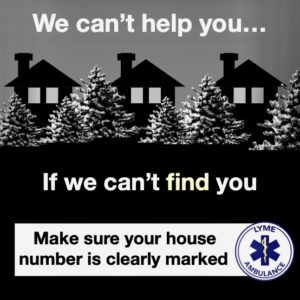
- Easy to see from the road: 3″ high+
- Visible from either direction
- Easy to read in the dark (reflective)
- Visible above the snow line
- Entryway easy to find
- If you have trouble marking your house or are unsure if your marking is visible enough, call us (860-434-7225) and we’ll be glad to help
A town ordinance passed in 2007 dictates that “numbers shall be a minimum height of 3 inches, of a color contrasting with its background, and preferably reflective. …Residences that do not have mailboxes shall display a number affixed to a post or other structure, not more than ten (10) feet from the intersection of that driveway and the road or street, and visible and unobstructed from either direction. Numbers shall be placed not less than 3 feet nor more than 8 feet above ground level.
IF YOU
CALL 911
▼
▶︎ Tell the dispatcher if there’s anything we need to know to find and access your house (such as a gate code)
▶︎ Turn on outside and inside lights
▶︎ No outside lights? Face your car towards the road and turn on the hazard lights or headlights
▶︎ Unlock the front door
▶︎ Shut any dogs in another room (we love dogs, but barking makes it hard to hear)
▶︎ Be sure to keep your driveway plowed in winter to ensure access for emergency services (ambulance and fire)
Consider installing a Knox box if you are incapacitated or would have difficulty getting to the door. A Knox box allows secure emergency access for firefighters and emergency medical services (EMS). Call the Lyme Fire Company if you would like to arrange for a Knox box (860-434-1329).
TIP #3
Know the signs for stroke and heart attack

Doctors recommend three simple questions if you’re concerned someone may be having a stroke:
- Can you smile?
- Can you raise both arms?
- Can you talk?
Any difficulty?
CALL 911 IMMEDIATELY!
Know and watch for the signs and symptoms of heart attack and stroke. This is particularly important if there are older household members or anyone with uncontrolled high blood pressure or known cardiac issues. Recognize that men typically resist help: make the decision to call 911 for them. If you think something is ‘off’ or wrong with you or someone else, you’re probably right. Time is of the essence, particularly with cardiovascular events: Don’t wait to call 911!
There’s no penalty or recriminations for false alarms. We’re just relieved that everything is OK. Really.
Lyme Ambulance encourages everyone to take our FREE ‘Hands-only’ CPR class. Upcoming classes are posted on our homepage — or call (860) 434-7225.
Learn important
signs and symptoms
▼
Strokes
- Sudden weakness or numbness of the face, arm or leg on one side of the body.
- Tremors or shaking on one side of the body.
- Sudden dimness or loss of vision, particularly in just one eye.
- Loss of speech, or trouble talking or understanding speech.
- Sudden, severe, unexplained headaches.
- Unexplained dizziness, unsteadiness or sudden falls, especially with any of the previous symptoms.
Heart Attacks
- Uncomfortable pain, pressure, a squeezing sensation or stabbing pain in the chest that lasts more than a few minutes, or goes away and comes back
- Pain radiating to shoulder, neck, arm or jaw
- Pounding heart or change in heart rhythm
- Difficulty breathing
- Nausea, vomiting, abdominal pain
- Cold sweats or clammy skin
- Dizziness
- A feeling of anxiety or panic
- Heartburn
Women and Heart Attacks
Compared to men, women may be more likely to experience:
- Feeling of breathlessness, often without chest pain of any kind
- An ‘unusual’ feeling or mild discomfort in the chest or back
- A burning sensation in the chest, often mistaken as heartburn
- Pain or tingling in upper back, shoulders, neck or jaw
- Flu-like symptoms – specifically nausea, clamminess, body aches or cold sweats
- Unexplained and sudden onset of fatigue, weakness or dizziness
- Feelings of anxiety
Dial 911 immediately
if you suspect
stroke or heart attack
DON’T DELAY!
Every minute matters
TIP #4
Audit your home for safety

What can you fix or improve, around the house and in the yard, to help defend against common household accidents like:
- Slips, trips, and falls
- Fire
- Accidental poisoning
INSPECT all staircases in and outside the house. Repair loose steps and handrails. Replace worn carpeting or treads. Remove clutter from the steps. Eliminate slipping and tripping hazards like throw rugs or tack them down.
TEST smoke alarms and replace batteries on schedule (Daylight Savings Time is a good reminder.) Check that fire extinguishers are sufficiently charged and in good repair.
CHECK your medicine cabinet and safely dispose of outdated prescriptions (do not flush!) Secure all drugs from curious children. Take care that toxic and caustic chemicals are out of reach of young children, including in the cellar and garage.
EVALUATE your personal safety needs: Do you have a problem with balance, vision or hearing? Consider adaptive devices like hand-holds or walking aids, more and brighter lighting, and vision- or hearing-assist technology.
Falls are the #1 cause of injury for seniors
▼
Recommended Reading
One Hundred Tips and Recommendations for Preventing Falls
Emergency Button: Medical Alert Wearables
TIP #5
Know how to stop bleeding
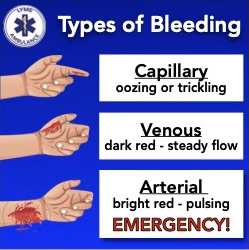
Bleeding from capillaries usually stops on its own (think finger prick) and bleeding from a vein can be controlled most often by simply applying steady pressure for a few minutes using a clean cloth or bandage. Seek medical attention if:
- Blood keeps oozing after 10 minutes
- Ragged or gaping edges
- Deep puncture wound
- Animal or human bite
- Facial wound
IF YOU SEE ARTERIAL BLEEDING
▼
(bright red or yellowish color, pulsing or spurting with the heartbeat)
Call, or have someone CALL 911 IMMEDIATELY while you press a folded clean cloth against the wound as hard as you can with both hands until EMS arrives. If the wound is deep, wad the cloth — your shirt will do in a pinch — and stuff it into the wound, place both hands on top and push as hard as you can until help comes. Do NOT lift the cloth to check on bleeding.
You never know when you might be first on the scene of a traumatic injury. It could be a loved one. Or you might be the victim yourself. Join the million+ people nationwide who’ve taken the course to learn how to ‘STOP The Bleed‘.
Watch this video to see how you could make ALL the difference in someone’s life: When minutes count, YOU may be the only help and hope there is until EMS arrives.
Consider purchasing a bleeding control kit for your home and/or car. You don’t have to have one to save a life — but it helps. Instructions for use are included in the kit. Call Lyme Ambulance (860) 434-7225 for the name of a recommended kit.
TIP #6
Learn hands-only CPR
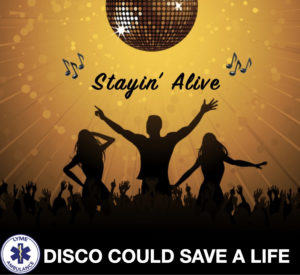
Remember disco?
The dance music craze of the 1970s? One song in particular, ‘Stayin’ Alive’ by the BeeGees, is the perfect tempo for ‘hands-only’ CPR chest compressions. Perfect song title too 🙂
To listen to the song ‘Stayin’ Alive’ on YouTube, click here
Click HERE to learn about Sudden Cardiac Arrest and how CPR can save lives
While our community classes are on hold due to Covid-19, you can get the basics of ‘hands-only’ CPR by watching this one-minute video from the American Heart Association:
You should know where Automatic External Defibrillators (AEDs) are located. If needed and nearby, send someone to get it while you start chest compressions. Current AED locations include:
- Lyme Town Hall
- Lyme Public Library
- Lyme Consolidated School
- Hamburg Fire Station
- Hadlyme Fire Station
We will be adding to the list of locations. You can also buy an AED yourself. Lyme Ambulance is working on a program to obtain AEDs at a discount for residential use. Contact Lyme Ambulance Chief of Service, Steve Olstein, at 860-941-9603 for more information.
Watch a brief video on how to use an AED:
TIP #7
Disasters happen
Have a plan
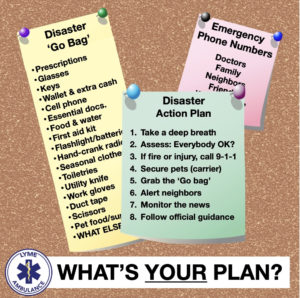
You probably don’t spend a lot of time thinking about disasters like major fires, floods, chemical spills, or long-term power outages — but you should give some thought to what you can do now to best prepare your household for whatever may come.
Be prepared
Stay safe
▼
PLAN for the most common or likely types of disasters where you live; flooding, for example, is a concern mainly in low-lying areas
KNOW HOW to turn off your water, gas, and electricity at the main source in case of an emergency
TEACH children how and when to call 911
MAKE SURE all responsible household members know where fire extinguishers are and how to use them; hold family fire drills
DECIDE where to meet in case you become separated; designate a contact person (out-of-town relative or friend) who can help track and coordinate for your family if public utilities are down
LEARN: Take a basic course in first-aid; learn ‘Hands-only’ CPR and ‘STOP The Bleed’; keep a well-stocked first-aid kit on hand
CONSIDER keeping a ‘Go Bag’ at the ready and stocked with supplies your household would need if you had to evacuate your home in a hurry
TIP #8
Need help in an emergency?
Let us know
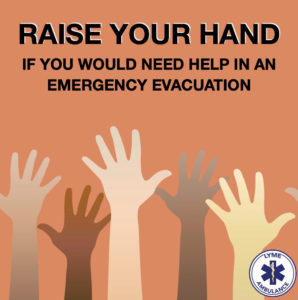
Would you need help in the unlikely event of emergency evacuation or if there’s an extreme weather event? If you are disabled, vision- or hearing-impaired, or have other special needs, let us know. Fill out a confidential ‘Special Needs’ form so we can ensure you receive notification and assistance when necessary, or just a check to make sure you’re OK.
Find the form at the back of Lyme’s annual report or by clicking on the link below. Mail the completed form to Lyme Emergency Management at the Lyme Town Hall: 480 Hamburg Road, Lyme, CT 06371.
Click: Special needs form
We can’t help you if we don’t know you’d need help
Feel secure knowing the town of Lyme is supported by dedicated and well-trained emergency services providers. Lyme Emergency Management Department, Lyme Fire Company, and Lyme Ambulance are all here to help the residents of Lyme. Any time. Every day.
Tip #9
Flashing green or blue lights? Move over!
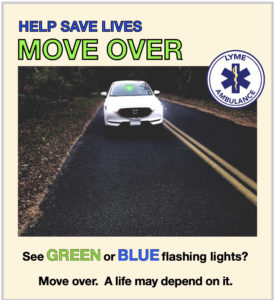
When you see green or blue flashing lights, the vehicle is responding to an emergency
Pull over!
A life may depend on it
Emergency personnel are permitted by the State to display flashing lights on their personal vehicle when responding to the scene of an emergency. When you see one in your rear-view mirror, pull over and stop. Green lights indicate ambulance personnel, and blue is used by firefighters. When you see a vehicle approaching you with one of these flashing lights, please pull over to the right as far as possible and STOP.
 Lyme Ambulance Association, Inc.
Lyme Ambulance Association, Inc.